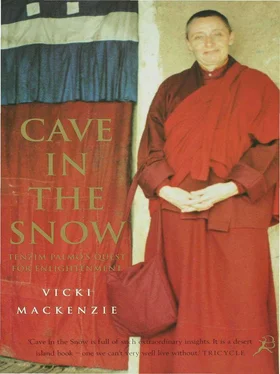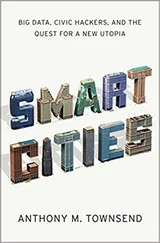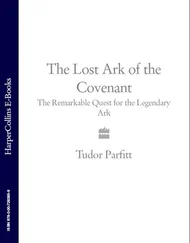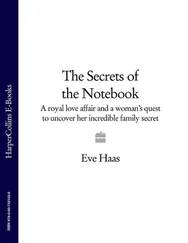Wasn’t there anything she missed?
‘I missed my lama, apart from that nothing. I was very happy there and had everything I wanted,’ she said quietly.
But wasn’t going to a cave an escape, an evasion of the trials of ‘ordinary’ life, I went on, quoting the argument most levelled at hermits by those of us engrossed in the mundane.
‘Not at all. To my mind worldly life is an escape,’ she retorted, quick as a flash. ‘When you have a problem you can turn on the television, phone a friend, go out for a coffee. In a cave, however, you have no one to turn to but yourself. When problems arise and things get tough you have no choice but to go through with them, and come out the other side. In a cave you face your own nature in the raw, you have to find a way of working with it and dealing with it,’ she said. Her logic was irrefutable .
It was a memorable meeting. Tenzin Palmo was, as I had witnessed from a distance, remarkably open and affable.
She was talkative and highly articulate too, and displayed a sharp, penetrating mind. She had also revealed a distinctive down-to-earth quality which immediately dispelled any cliched notion of a ’spaced-out meditator’. And behind the vivacity was a profound stillness, an immense inner calm as though nothing could, or would, disrupt her, no matter how galvanic.
All in all, I concluded, she was a woman of stature. When the course was over I thought it unlikely our paths would ever cross again. Then one day, some months later, I picked up a Buddhist magazine and found inside an interview with Tenzin Palmo. About half-way through, buried in the middle of the text, was one small sentence:
‘I have made a vow to attain Enlightenment in the female form – no matter how many lifetimes it takes,’ Tenzin Palmo had said.
I stopped. The effect of her words was electrifying, for what Tenzin Palmo had stated in that casual, almost throwaway manner was nothing short of revolutionary. What she had promised was to become a female Buddha, and female Buddhas (like female Christs and female Mohammeds) were decidedly thin on the ground. Certainly there had been plenty of acclaimed women mystics and saints in all parts of the world, but the full flowering of human divinity had, for the past few thousand years at least, been deemed the exclusive domain of the male. The female body, for some reason, had been seen as an unfit or unworthy vessel to contain the most sacred. Now Tenzin Palmo was publicly announcing that she was intending to overthrow all that. It was a bold, courageous statement. A reckless one, even. One that could easily be dismissed as a piece of bravado or wishful thinking, had it not been Tenzin Palmo with her track record of exceptional meditational ability and tenacity who had made it. It could just be possible that she might do it! If not in this lifetime, then maybe the next or the next.
My hopes rose. This was something I had been waiting for for years. From the very beginning of my search into Buddhism I had been told that we all possessed the seed of full awakening, men and women alike. It was our birthright, our natural inheritance, the lamas had said from their high brocaded thrones. Buddhahood was there shining within, like a pearl of great price, and all we had to do was to uncover it. The responsibility was ours, and ours alone. How the philosophy had appealed to an independent woman making her own way in the world! It took lifetimes of diligence and effort, the lamas continued, but if we set out on this journey eventually the magnificent prize would be ours.
That, at least was the theory. In actuality, however, examples of female spiritual excellence were decidedly thin on the ground. Yes, there were female Buddhas aplenty in paint and plaster paying homage to the ideal of feminine divinity in all its diverse and wonderful forms. You could find them dotted all around temple walls and throughout the monastery gardens, worthy objects of veneration and prayer. Some were beautiful, some peaceful, others powerful or overtly erotic. But where were the living examples? The more I looked the more I could see no sign that women were getting anywhere in the spiritual selection stakes. The lamas who taught us were male; the Dalai Lamas (all fourteen of them) were male; the powerful lineage holders who carried the weight of the entire tradition were male; the revered Tulkus, the recognized reincarnated lamas, were male; the vast assembly of monastics who filled the temple halls and schools of learning were male; the succession of gurus who had come to the West to inspire eager new seekers were male. Where were the women in all of this? To be fair, it was not just Tibetan Buddhism which was so testosterone-heavy, but Buddhism from Japan, Thailand, Sri Lanka, Burma – in fact from all Eastern countries with the possible exception of Taiwan. (Even my own home-grown religion, Christianity, with its insistence on a male God and its fear of female priests, was no better.) Where were the female gurus for us women to emulate? What in fact did female spirituality look like? We had no idea. The fact was that in spite of the Buddha’s word that we could all advance up the spiritual evolutionary ladder to Enlightenment there was no proof that women could actually do it. To the women practitioners sitting at the lamas’ feet earnestly trying to follow The Way, it was discouraging to say the least.
How urgently we needed hope that the impossible could become possible. How badly we women needed champions to lead the way. It was time. The twentieth century had seen the steady and inexorable emancipation of women in all areas of life, except that of religion. Now, at two minutes before the millennium, it seemed that the last wave of female emancipation was poised to begin. If it happened it would also be the greatest. The ultimate women’s liberation was surely a female Buddha, an omniscient being. In the light of her great intention, Tenzin Palmo’s already remarkable achievement of enduring twelve years of meditation in a Himalayan cave was suddenly thrust into the realm of universal endeavour.
I decided to seek her out again. There was now so much more to know. Who exactly was she, where had she come from, what had she learnt in that cave, what had prompted her to make that vow – and would she mind being the subject of a book? Reluctantly, very reluctantly, she agreed, and then only on the grounds that it would inspire other women, and help her own project currently under way to facilitate women’s enlightenment. And so over the next year I tracked her down, in Singapore, London, Seattle, California and India where she was leading a very different way of life, and gradually pieced together the elements of her extraordinary and, some would say, most unnatural life. I spoke to people who had known her and visited the places which had been central to her life. With great difficulty I even found her cave and, having climbed to that thin-aired altitude and witnessed for myself her dwelling place, marvelled with new appreciation at what she had accomplished.
This then, is Tenzin Palmo’s story – a tale of one woman’s quest for Enlightenment.
Chapter Two
The Wrong Place
The world that Tenzin Palmo came from could not have been further removed from the one that she was to find herself in.
She was born in a stately home, Woolmers Park, in Hertfordshire, in the library to be exact. This was not because she was of blue blood, far from it, but because on 30 June 1943, the day of her birth, Hitler’s Luftwaffe were blitzing London and the capital’s maternity hospitals had been evacuated to the relative peace of the home counties. Something must have gone terribly wrong with the mathematics, because although she was technically overdue and was induced she arrived into this world with no eyelashes, no fingernails, no hair and was, even her mother said, quite ugly; however, in spite of the wizened child’s unprepossessing appearance, her mother was filled with romantic aspirations for her and promptly named her Diane after a popular French song that had caught her fancy – but, she insisted, it had to be pronounced in the French way which, with the English pronunciation, came out as ’Dionne’. This was how she was known until her ordination as a Buddhist nun some twenty-one years later, when she took the second name of Tenzin Palmo.
Читать дальше












